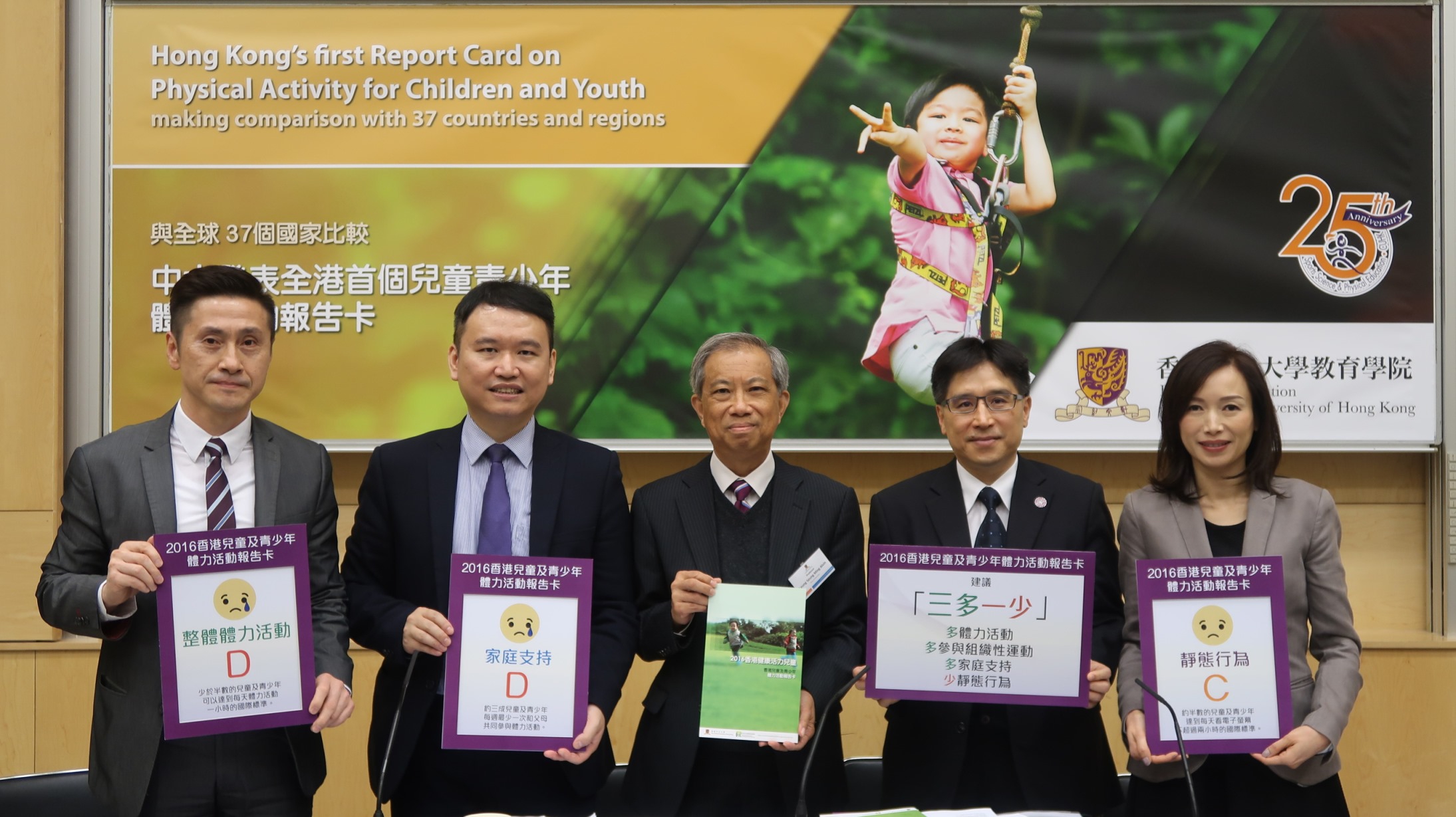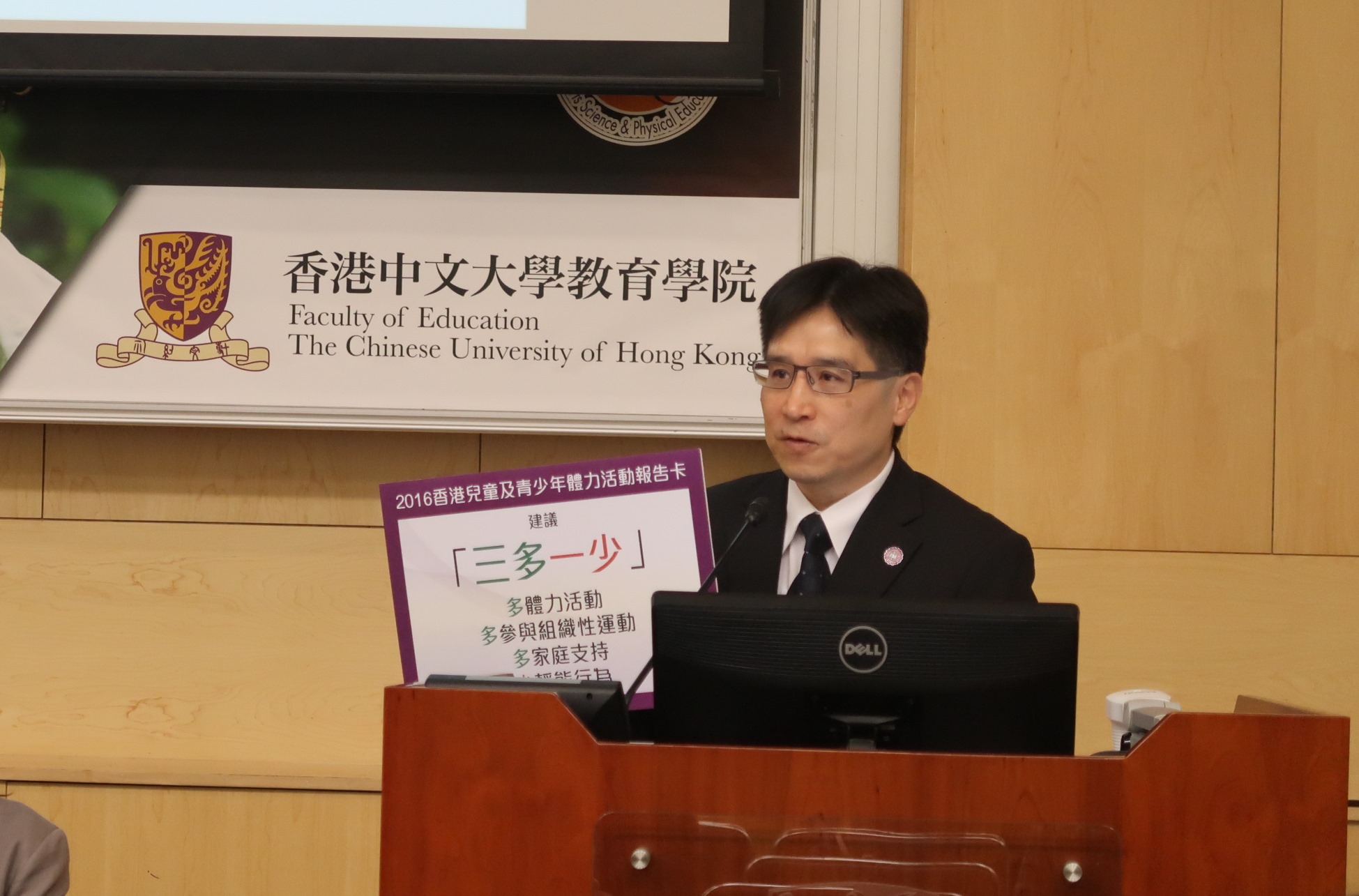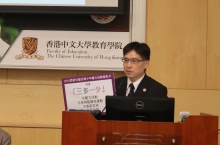CUHK
News Centre
CUHK releases Hong Kong’s first Report Card on Physical Activity for Children and Youth making comparison with 37 countries and regions
An interdisciplinary research team, formed by professors in The Chinese University of Hong Kong (CUHK), has conducted Hong Kong’s first comprehensive and systematic analysis of physical activity in children and youth, making comparison with data from 37 countries and regions and suggestions on increasing physical activity among children and youth. The analysis was made in accordance with 9 international indicators established by the Report Card on Physical Activity for Children and Youth, including ‘Overall Physical Activity Levels’, ‘Organized Sport Participation’, ‘Active Play’ , ‘Active Transportation’, ‘Sedentary Behaviors’, ‘Family Support’, ‘School – Physical Education (PE), Physical-Activity-Related Policy, and Programs (School)’, ‘Community and the Built Environment’ and ‘Government Strategies and Investments’.
Worst performance in ‘Overall Physical Activity Levels’ and ‘Family Support’
The research shows that children and youth in Hong Kong have the worst performance in ‘Overall Physical Activity Levels’ and ‘Family’ with a grade D. In ‘Overall Physical Activity Levels’, less than half of the children and youth met the international recommendation of doing one hour of physical activity per day. In ‘Family Support’, only around 30% of children and youth had physical activity with the family at least once per week. Hong Kong achieves its best performance in ‘Active Transportation’ and ‘Community and the Built Environment’ with a grade B. Around 80% of children and youth travelled to school on foot or by bicycle. Almost 80% of the parents felt that the community is safe with low traffic and crime rate, and a majority of youth expressed satisfaction with the sport facilities provided by the government.
The performances in ‘Organized Sport Participation’, ‘Sedentary Behaviors’ and ‘School’ are average. The ‘Organized Sport Participation’ receives a C-, and both ‘Sedentary Behaviors’ and ‘School’ are graded C. In ‘Organized Sport Participation’, around 40-50% youth achieved the benchmark standard participation rate with more boys engaged in it than girls. In ‘Sedentary Behaviors’, around half of the children and youth spent less than two hours per day in electronic devices in accordance with the international recommendation level. In ‘School’, almost 80% of schools had two sessions of PE classes per week, with the actual time of the lessons 20% shorter than scheduled. Only 30% of schools had a documented physical activity policy. A majority of schools have held a sports day event or inter-school sports competition, but the number of actual participants in these events is unknown. In ‘Active Play’ and ‘Government Strategies and Investments’, due to insufficient data and lack of a preset benchmark, the team is unable to grade the performance in Hong Kong.
The research project is supported by a Knowledge Transfer Project Fund from CUHK. The core members of the research team include: Prof. Stephen Heung-Sang Wong, Chairman & Professor, Department of Sports Science & Physical Education, CUHK, Prof. Martin Chi-sang Wong, Professor, Jockey Club School of Public Health and Primary Care, CUHK, Prof. Cindy Hui-Ping Sit, Associate Professor, Department of Sports Science & Physical Education, CUHK, and Prof. Raymond Kim-Wai Sum, Assistant Professor, Department of Sports Science & Physical Education, CUHK.
Suggestions to increase physical activity in children and youth
Prof. Stephen Heung-Sang Wong, the chief investigator of the Report Card said ‘Society generally believes that the lack of physical activity in children and youth affects their growth. In response, the government has been actively promoting sports in the community. But the physical activity of children and youth in Hong Kong has not been analysed comprehensively and systematically according to international indicators. Through this research, the team hopes to provide data for the reference of the government when implementing related sports policy.’
He continued, ‘Cooperative efforts among the government, family, school, children and youth are required, to increase the physical activity level of children and youth. In accordance with the research results of the Hong Kong Report Card on Physical Activity for Children and Youth, the team suggests improving their deficiency in sports by increasing the amount of physical activity and organized sports participation, providing them with more family support, and reducing their level of sedentary behaviors.’
In families, the research team thinks that parents should encourage children and youth to participate in active play and organized sports and to build up the habit of walking and reducing sedentary behaviours (like using electronic devices for a prolonged time). Parents should also accompany their children in participating in physical activity to reduce their reliance on electronic devices. In school, apart from increasing the time spent on sports activity, teachers should reflect on the design of PE lessons, and make them more appealing to students to increase their engagement in sports. In the government, the research team suggests that, apart from implementing policies that increase students’ physical activity, they should also establish a system for estimating its efficiency that aids its evaluation. In terms of academic research, researchers should place more focus on studying the active play of children and youth. Cooperation with NGOs and the government to enhance the evaluation of the projects and policies that promote sports activity, should also be facilitated.
Comparison of Hong Kong with 37 countries and regions
Of ‘Overall Physical Activity Levels’ and ‘Family’, the two indicators in which Hong Kong performs the worst when compared to the report cards from other countries, the former has resulted in a performance similar to the average global grading. This shows that the general trend in overall physical activity in the world is low. The latter indicator fell behind other countries, irrespective of comparisons made with high income countries (Appendix 1) or the nine Asian countries (Appendix 2). ‘Active Transportation’ and ‘Community and the Built Environment’, the two best indicators for Hong Kong, are exceptional performances globally, in that they surpass the global average. Hong Kong is even ranked the best among the nine Asian countries in these two indicators.
‘School’ and ‘Sedentary Behaviors’, the indicators with an average performance by Hong Kong, remain mediocre by global comparison. In ‘School’, Hong Kong outperforms Korea (grade D) but falls behind Japan and mainland China (Grade B and B+ respectively). In terms of ‘Sedentary Behaviors’, Hong Kong, the Netherlands, Sweden, Japan and New Zealand are all graded C, which outperforms the United States and Australia (grade D-), whereas Canada, Scotland and Korea score the worst performances globally with the grade F. For ‘Active Play’ and ‘Government Strategies and Investments’, Hong Kong, like many other countries and regions, can’t be graded due to insufficient statistics.
Report Card on Physical Activity for Children and Youth
The Report Card on Physical Activity for Children and Youth is a global collaborative project originating in Canada. Evaluations and global comparisons are made according to related indicators of the physical activity of children and adolescents in different countries and regions. These indicators have been adopted by 38 countries and regions from six continents, including: the United States, Canada, Australia, New Zealand, Japan, Korea, China, Thailand, UK, Ireland, Finland, Norway, Kenya, South Africa and others. Through publishing these results, the research team aims to provide evidence based analysis to government for sports and leisure policy implementation, and further increase the physical activity of children and youth. The result of the report card for other countries and Hong Kong can be read through the website: www.activehealthykids.org and activehealthykidshongkong.com.hk
(From left)Prof. Raymond Kim-Wai Sum, Assistant Professor, Department of Sports Science & Physical Education, CUHK, Prof. Martin Chi-sang Wong, Professor, Jockey Club School of Public Health and Primary Care, CUHK, Prof. Leung Seung-ming, Alvin, Dean, Faculty of Education, CUHK, Prof. Stephen Heung-Sang Wong, Chairman & Professor, Department of Sports Science & Physical Education, CUHK and Prof. Cindy Hui-Ping Sit, Associate Professor, Department of Sports Science & Physical Education, CUHK
Prof. Stephen Heung-Sang Wong, the chief lead investigator of the report card introduces suggestions to increase physical activity in children and youth.







